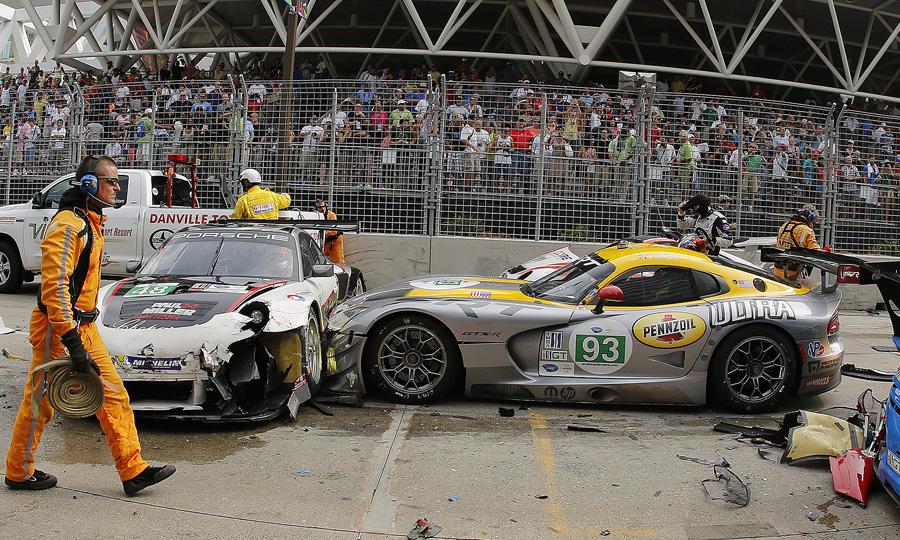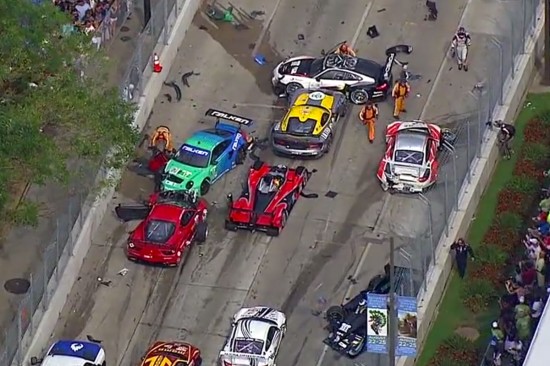Polesitters Get No Respect Anymore
 |
| Carnage at the start |
| AutoWeek |
Race series could prevent so many of their own problems if they would simply allow the pole sitter to do his job.
Every driver's meeting across the country is plagued with endless speeches dictating what the drivers must do at the start of the race. Here are a few of the pre-race instructions I've been given just over my past twenty races or so…
- You can accelerate once you reach the white stripe on the asphalt
- You must accelerate simultaneously – as if you could drive your opponent's car for him – and cross the start/finish line two abreast
- You cannot accelerate until you see the green flag
- You must accelerate when the green light comes on
- You must be going 60 mph at the first cone and 80 at the second (note to rules makers – we don't have speedometers)
I've seen Race Directors and flagmen ramble for fifteen minutes desperately trying to micro-manage the start of a race and still fail to get a decent start for one simple reason – they insisted on stripping the pole sitter of his rightfully earned authority and re-assigning it to the series.
Look, this is really easy. Everyone gets an equal shot at the pole. If you win the pole, you win the right to pace the field. You earned it. When the pole sitter goes, everyone goes. If the pole sitter hasn't accelerated, no one accelerates. If I don't like where the pole sitter accelerates, I can go win the pole next time and do whatever I want.
 |
| Carnage at Turn 1 |
| AutoWeek |
The flagman shouldn't decide when a race starts. The Race Director shouldn't decide when a race starts, nor should he decide the speed that the field must maintain to start a race. There is no need to accelerate simultaneously or reach a painted stripe on the racing surface or any of the other choreographed, nonsensical instructions given to drivers. The field belongs to the person who earned the pole. His job is to allow the field to properly align, and then choose when and where the field will accelerate.
The American Le Mans Series had all sorts of problems at Baltimore last month because they failed to heed the authority of the pole sitter. The second-place starter jumped quickly and everyone else followed, assuming – correctly – that the series would ignore the pole sitter’s pace and throw the green flag anyway.
 |
| Carnage at the start |
The fact that an awkward pair of chicanes were plunked down in the center of the track at the beginning of the main straightaway didn't help, either. Chicanes are the opposite of racing. They are supposed to slow drivers down. Racing is supposed to speed them up. But I digress.
The chicanes were placed in the center of the track. The field was to preserve the side-by-side rows of two by driving to each side of the chicanes at the start of the race, and observe the chicanes for every lap thereafter.
You could see this coming a mile away. The pole sitter kept a steady pace while the second-place car nailed the throttle and left the field. The green flag was thrown and the accordion effect began, with mid-pack cars suddenly rear-ending each other.
The result was an ugly, 7-car pileup before a national television audience on ABC and an embarrassingly long cleanup process.
While this incident was particularly nasty, the same basic scenario is repeated weekly at oval tracks and road courses around the country in both major series and amateur events. Occasionally, series and track officials appear to be concerned that the pole sitter will take the lead in the first turn, yet this is precisely what is supposed to happen. That is not an unfair advantage. It's the advantage that rightfully belongs to the driver who earned it.
Racing has become the most over-regulated sport in the world. Robbing the pole sitter of his rightful authority over the field and awarding it to flagmen and race directors is but one symptom of a much bigger disease… but hey, it's a good place to start.
Clean up auto racing. Let the pole sitter do his job.
Stephen Cox

